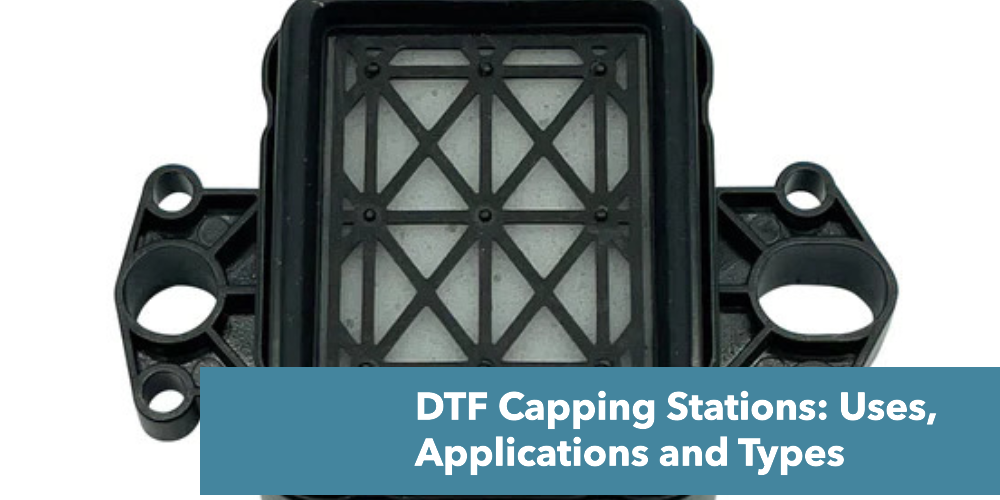What is a Capping Station in DTF Printing?
A DTF capping station helps keep your printer running smoothly by protecting and maintaining the print head. When you finish printing for the day, you park the print head in the capping station. It saturates a special cap on the print head. This keeps the nozzles moist and prevents ink from solidifying, which could block them and prevent future printing.
Some capping stations also include a waste ink pump. This pump helps clean up leftover ink and prevents the waste ink tube from getting clogged.
How Does Capping Station Work in DTF Printing?
The capping station in your DTF printer keeps your printer running smoothly Here's how it works:
Fresh ink supply: It ensures your print head always has a steady flow of ink by drawing fresh ink from the cartridges or dampers.
Cleaning crew: It acts like a tiny janitor, wiping away waste ink and keeping the print head clean. This prevents clogs and ensures sharp, crisp prints.
What are the Uses of the Capping Station in DTF Printing?
The capping station plays an essential role in keeping your prints looking their best. It protects your print head, sealing it whenever your printer is idle. This prevents ink from drying out and clogging the delicate nozzles, ensuring smooth operation and clear prints when you return to printing.
But the capping station's job goes beyond just protection. It also contributes to the overall health of your print head by performing cleaning cycles. This helps to remove any ink residue that could build up and affect print quality. By keeping the print head clean and primed, the capping station ensures consistent performance and delivers vibrant, high-quality prints.
Finally, the capping station helps maintain a healthy printing system by regularly flushing the waste ink tube. This prevents blockages that could disrupt the printing process and potentially damage your equipment. With a clean waste ink tube, you can be confident that your DTF printer will continue to operate smoothly and efficiently.
How Does the Capping Station Maintain the Printhead in DTF Printing?
The capping station plays a vital role in keeping your DTF printer running smoothly. First, it acts as a seal for the printhead whenever the printer is idle. This prevents ink from drying out on the head, which can cause clogs and hinder printing performance.
Secondly, the capping station facilitates short-term maintenance routines. By using a capping station solution designed specifically for your printer model, you can soak the printhead nightly. This keeps it moist and prevents ink buildup or debris accumulation.
Thirdly, the capping station helps you save ink and extend the lifespan of your printer. When the printer isn't in use for extended periods, excess ink is flushed into the capping station instead of being wasted.
However, to maintain optimal performance, you'll need to clean the capping station itself regularly. This involves removing any excess ink, cleaning the station with a suitable solution, and drying it completely before closing the printer. Regular cleaning helps prevent ink smudges and streaks on your prints and reduces the chances of printer errors.
Is the Wiper Blade in the Capping Station Essential for DTF Printing?
The wiper blade is a critical component in your DTF printer, responsible for keeping the nozzle clean. Located under the nozzle, typically on the left side of the ink stack, it wipes away excess ink after a cleaning cycle or ink purge.
To ensure optimal printing performance, you should check the wiper blade regularly for signs of wear or damage. Some recommend replacing it every three months for preventative maintenance. Alternatively, you can inspect it whenever you notice printing defects like ink streaks or smudges and replace it only when necessary.
A clean wiper blade guarantees efficient cleaning of the print head, preventing printing issues and contributing to the overall health of both the print head and capping station.
Does the Capping Station Affect the Ink Drying Time in DTF Printing?
Yes, the capping station in DTF printing does affect the ink drying time. By creating a semi-airtight seal around all the ink nozzles, the capping station protects the ink from drying in the printhead, which can lead to clogs, especially with water-based inks like DTF ink. This seal helps regulate the ink drying process, ensuring that the ink remains in optimal condition for printing without drying prematurely. Regular maintenance of the capping station, including cleaning the wiper, ink accumulation guide groove, ink guide tank, and other components, is essential to prevent ink solidification and maintain proper ink flow within the printer system.
Are there Different Capping Station Designs for Various DTF Printer Models?
Yes, different DTF printer models require specific capping station designs. This is because the capping station needs to be tailored to fit the printhead and mechanics of your particular printer model, like the i3200 printhead, Epson XP600 printhead, or DTF-1390 printer. A well-matched capping station ensures compatibility and optimal performance for your printer. In other words, the design variations cater to the specific needs of different DTF printers, giving you the option to customize and maintain your machine based on its model.
Does Using a Capping Station Cap Improve Ink Preservation in DTF Printing?
Yes, a capping station cap is essential for ink preservation in DTF printing. It works like a sealed lid for your printhead, keeping things fresh in a few keyways.
First, it prevents the ink from drying out. Unlike some other inkjet inks, DTF inks are pigment-based and much more susceptible to drying on the printhead. This drying can clog the delicate nozzles and lead to printing problems. The capping station cap acts as a barrier, keeping air away from the ink and maintaining its moisture.
Second, the cap minimizes ink evaporation. Even a small amount of evaporation can affect the consistency of the ink and ultimately, the quality of your prints. By creating a closed environment around the printhead, the cap reduces the surface area exposed to air, slowing down this evaporation process.
Finally, the cap protects the printhead from dust and debris. Any foreign particles in the ink can cause clogs and disrupt printing. The cap acts as a shield, keeping your printhead clean and ensuring smooth ink flow.

